Celebrating Syria: “We couldn’t go back, so we started mamnoon instead.”
-Richard Bangs
“For us, there is only the trying. The rest is not our business.”
-T.S. Elliot
There are so many delicious facets to this story. I first met Wassef Haroun in Zambia, at the Kafue River Camp, owned by a mutual friend who had invited us for a week-long private safari. Towards the end of the week Wassef excused himself from the Rhodesian teak table overlooking a bloat of hippos, and ventured back to the open kitchen where he spent several hours baking bread in the 90 degree heat. Any thoughts of insanity were quickly dispelled when he produced the unleavened Arabic flatbread, man’oushe, and I fell into its flavor. It was astonishingly scrumptious. And it was the beginning of a journey that led to mamnoon.
Wassef and his wife, Racha, are both from Syria, with family roots throughout the Middle East, though they have lived in the US for over 20 years. They feel they are “hybrids,” a fairly uncommon group of people who has a deep understanding of and gratitude for both Levantine and Western cultures. Wassef left Damascus to attend school in the U.S.; Racha left Hama, in Northern Syria, in 1982, when an uprising against the government led to the Hama massacre, in which an estimated 40,000 were killed.
In the U.S., Wassef went onto a successful career as a Microsoft executive; Racha sank teeth into the Seattle cultural community, and relished the role of full-time mom. Both watched from a distance as recent matters in their home region began to once again headline the news. They could have easily assimilated into their new world, turning backs on their beginnings, but they wanted to do something to counter and breakdown stereotypes about their origin region; something that might build an accessible bridge between the different cultures, religions and geographies.
What might they do?
When I broke bread with Wassef in Zambia he had just returned from Lebanon, where he had apprenticed for a week in a street corner bakery, learning the art of bread-making. Between the lions and hippos of Kafue we were the first to sample Wassef’s latest artistry, and destiny.
Though neither Wassef nor Racha had any experience in the restaurant business, they loved to entertain, and Racha, especially, loved learning to cook the foods they grew up eating. They prized the social elements of having friends and family over for a meal, a deep tradition in the region, where the “open tent” philosophy was born, and for most of history was a model of secular coexistence. They wanted to do something that celebrates the diversity and inclusive nature of Middle Eastern society. Food, after all, is the universal envoy. Why not, then, open up a restaurant, to pursue a passion, to honor ancestries, to integrate their stories, and spread the good confidences of their culture through the heralds of food?
Racha tells me, “We felt like it was time to do something because we couldn’t go back home. I used to take my children for six weeks each summer. Over the last three years, we haven’t been able to go back. It was almost natural to do something bigger than just having parties at home. We wanted to share our love for our country with those in this country.”
They started the project culling from their own mothers’ and grandmothers’ kitchens, and by hiring celebrated Lebanese cookbook author Barbara Abdeni Massaad, bringing her to Seattle for several weeks of consultancy.
The result is mamnoon, “thankful” in Arabic and Farsi, an apt appellation for a place that nods to the animated cuisine of Lebanon, Persia and Syria. Hospitality is a keystone to the culture, and their tables. Their hope is that the experience is a “transformative step” towards acknowledgement of the warmth of the region, and of their own values.
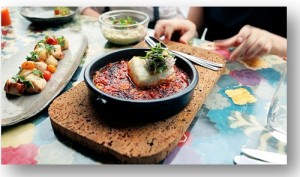 I joined Wassef and Racha at the opening of mamnoon in November of 2012, and it was a busy fête, packed with family and friends, some of whom whispered, “They just don’t know what they are getting into.” But I know from experience sometimes it’s the uninitiated, those unburdened by familiarity, who fire the impossible kilns.
I joined Wassef and Racha at the opening of mamnoon in November of 2012, and it was a busy fête, packed with family and friends, some of whom whispered, “They just don’t know what they are getting into.” But I know from experience sometimes it’s the uninitiated, those unburdened by familiarity, who fire the impossible kilns.
So, a year after the opening, I return to mamnoon to check in on what Wassef calls “the experiment.”
What I find is a gathering of guests from a range of cultures and lifestyles, and the Harouns actively greeting and serving as though born to host. But there is some frustration as well. Wassef has noticed that some passersby and visitants assume mamnoon is just another falafel shop, a hole-in-the-wall that features huge portions and garlic that stays in the mouth three days after a meal. Some hungry folks just pass by, powered by the assorted negative stereotypes around Middle Eastern food in the US. Yet, for those who dare come in, they discover something deeper, more far-reaching, than comfort food or stomach filler. Mamnoon is, in several ways, a disequilibrium that works, marrying cool modern with warm ancestral; selective austerity with uninhibited richness; take-out street food with elegant dining. Bruce Springsteen, in his 2012 SXSW Keynote, said “Be able to keep two completely contradictory ideas alive and well inside your heart and head at all times.” In their own progressively traditional way, Racha and Wassef have done this.
There is, of course, a bar, with seductive-sounding cocktails, and all the usual liquid suspects lined up in the back, but with no patron stools up front. Wassef says barstools make for solitary experiences, a Western conceit, and the Syrian way is to sit at a table and socialize. Viniculture, many believe, originated some 9000 years ago in the Middle East, as a social supplement. “We encourage sharing,” says Racha, “Sharing is a big part of culture. In the old days, we sat in tents and all ate from the same plates.”
The décor at mamnoon is cosmo-minimalist, steel girders riding the high ceiling of a former two-story garage, but Racha has installed clutches of hand-blown candy-colored Syrian lights, shaped like giant grapes, that remind her of the streets of Damascus.
Then there is the contrast between complexity and simplicity. Bread, or khobz in Arabic, is a symbol of simplicity, the staff of life, a food almost every community enjoys. And the never-ending bread served through the up-front cubby is, in relative terms, guileless and unpretentious. But the food served in the main dining room is rich and labyrinthine, bucking the fashion of overly artless food.
The recipes are old….some dial back 5000 years; yet the preparations are original and new, finely mixed with local ingredients.
There is, throughout, a new spirit, braided with an old soul, “a soul that can’t be suppressed,” says Wassef.
The food is irrefrangible and serious, but nobody at mamnoon takes himself too seriously, and most sport t-shirts with a winking, flirting, Middle Eastern eye, a flash of fancy. “Many in the Middle East believe in the anti-evil eye, or the hamsa, “Wassef explains. “ A lot of superstition swirls around amulets and signs as protections against the evil eye. The wink is a bit of a play on that, and a little poke at such notions.”
Somehow, it seems, mamnoon has become a kind of living dialectic, time and ideas, food and architecture, passion and purpose, coming together in a pita of elegant coherence.
Before tasting, I take a tour. The first step brings to the nose the heady aroma of freshly baked dough, wafting from the giant oven on the right, a perpetual motion machine of bread. In Syria, everyone has bread…it is subsidized for the poor. But when the uprising started, the regime cut off flour supplies and bombed bakeries, some with queues of people in the streets. So, mamnoon’s ovens are now paeans to plenty. As of this writing mamnoon has served over 150,000 loaves of bread – free.
To the left is a communal table, a trompe l’oeil of geometric stars, arabesques, and floral designs, a mash-up of old Arab and neoteric design, commissioned by local artist Tina Randolph. Then there is the large formal dining area, with a variety of seating arrangements, to meet the different social permutations. Along the walls are simple shelves with brass teapots, vases and rows of hand-made glass votives. Why so many? A little further in, to the left, through a filigreed light-wood screen, lathed with eight-point stars, is a lounge with lush, red velour benches, a place where Sydney Greenstreet might make a deal with Peter Lorre, or Tom Skerritt, who actually dines here. The stools in this room were shipped from Syria, three years ago when still possible. “I’m not sure we could do that now,” Racha says. “We were lucky to get them out. The nice thing was the people involved, the Syrians, were so grateful we gave them some work, as nobody is ordering carpets or buying things now. Putting a container together of items for the restaurant was almost a blessing for those involved.”
And finally the exposed kitchen in the back, offering transparency, and honesty, to preparations and crew. “Guests are not disconnected from the hardworking people who are bringing the food to them,” says Wassef. “I think that’s really, really important.”
All about the restaurant there is diversity in action, enthusiasts from across borders and outlooks. Food doesn’t have religion, or political affiliation. Food makes no judgments. Some Sephardic Jews nosh at one table; covered Saudi women at another. There are men in business suits; girls in tattoos and piercings; Middle Eastern students learning English; Scandinavians trialing new spices. The crowd seems multi-ethnic, multi-national, all united over what Wassef calls “the visceral connector” of food.
After the lunch rush, I make my way to the main kitchen, the nidus of inspiration, and catch up with executive chef Garrett Melkonian, who studied for months to master the fare here, including a half-year stint in the Harouns’ home. He is overseeing an intricate array of preparations. Original spice blends are being ground; falafel fashioned from raw materials; lamb shoulders and beef being mixed for kofta. He tells me he has Egyptian-Armenian-Lebanese roots, on his father’s side, but growing up never really experienced the culture, so the chance to explore that legacy was alluring. But, the complexity of the food was a challenge. “This is a cuisine you have to earn,” he says. “It scared me a little bit at first.
“This is not fig on a plate. Nothing comes out of a box; nothing comes from a can.
“This is really about the transformative properties of food and ingredients. Take this muhammara. The Aleppo pepper paste takes two days to make, with walnuts, bread crumbs, lemon juice, pomegranate molasses, cumin and garlic, all aligned in perfect balance, so that within this simple bowl of rosy dip you can taste every single one of these ingredients, and it all comes together in a way that’s magic.”
Then there is the signature dish, bateresh, from Racha’s hometown, the northern city of Hama—charred eggplant with finely minced lamb.
“It’s this seemingly simple thing, but actually incredibly complex and nuanced. There’s the smoky, tart, garlicky, crunchy flavor from fried pine nuts; the sweetness from the spiced lamb ragù; the tang of brightness from the parsley on top. You look at it; it seems simple. Then you eat it, and there’re a million things going on. So, for me, getting each one of these elements right was really challenging, especially since I know the dish has profound personal meaning for Racha and Wassef. A lot of the food here they ate as children; the dishes evoke very specific, vivid memories, so I don’t want to be the guy who comes along and ruins that.
“I’d like to see mamnoon allow people to see the beauty in Middle Eastern cuisine, in the culture and hospitality, beyond anything portrayed in the media. There is personal meaning for me as well. Both my grandparents passed away, one while we were opening the restaurant. Through mamnoon I’m learning more about my own heritage, which I am passing along to my daughter, and hopefully she can pass to her children. I have the opportunity for this to be a link from my past to my family’s future, and perhaps the future of Middle Eastern cuisine. I hope if you come here, and you’ve been to the Middle East, this will make you nostalgic and happy; if you haven’t been there, then it will make you want to go.”
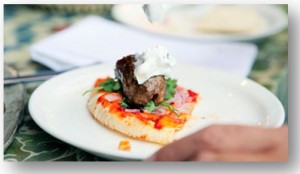 A little later Racha and Wassef at last have a break, so I sit down with them at a table festooned with shamandar bi tahini (grated beets bound with yogurt and tahini), baba ghanoush (lightly smoked eggplant mash lifted with lemon), khoresh (Persian stew), fūl (a mash of fava beans served with olive oil, chopped parsley, onion, garlic, and lemon juice), and, of course, the bottomless basket of warm bread.
A little later Racha and Wassef at last have a break, so I sit down with them at a table festooned with shamandar bi tahini (grated beets bound with yogurt and tahini), baba ghanoush (lightly smoked eggplant mash lifted with lemon), khoresh (Persian stew), fūl (a mash of fava beans served with olive oil, chopped parsley, onion, garlic, and lemon juice), and, of course, the bottomless basket of warm bread.
I ask why they chose “mamnoon” as the name, and Racha says: “Because we are so thankful for what America, and Seattle, have offered us, for welcoming us. We feel very lucky, very grateful being here, and for being so well-received by friends and the community. And we wanted to thank them back.”
Wassef pipes in, “Also, we hope this is how guests feel when they have the mamnoon experience. We hope they feel as grateful, thankful and satiated as we do.”
“You talk about this as an experiment. What do you mean by that?” I ask.
“When you conduct an experiment, it’s to attempt something unknown, and to try to figure out what will happen. So, for us, this is a complete unknown. We’ve never run a restaurant before. We’ve never been in the food business. Racha’s a trained counselor and mother of three. I’m a certified geek by any standard. To go from our backgrounds to what we are doing now is a big risk, a grand experiment, because we aren’t just offering up a cuisine that already exists. We didn’t just follow a formula to build a restaurant. We didn’t just find a better location. We are doing something atypical, new and different. We are putting traditional cooking in a context that’s very contemporary, and urban.
“Another part of the experiment is bringing street foods into the mix, at affordable price points. We’re hoping people here take to these street foods just as people do in Beirut, Damascus or Tehran.”
“What do you mean when you say food is a visceral way to connect?”
“I ate certain things while growing up, and still have vivid memories of these things. But I can’t express those memories in words. If somebody serves something I ate at 18, I will know exactly what it is 50 years later. I will know if it’s right or wrong. So, there is a visceral connection to memory through food.
“It’s richer than what you see on TV, or in a movie. It’s richer than anything on a smart phone. You simply eat it, and experience an explosion of flavors, and somehow your brain knows if it’s something, you’ve eaten before, or not. It can somehow bring you back in time to a hot day on a street in Beirut eating a man’oushe.”
Racha picks up: “There is another visceral connection as well. At home people sit around the table for hours and hours, and at breakfast they talk about lunch, and when they are at lunch, they think about dinner. Food is always a connector when people share it. No matter the nationality, the region, the faith; if the food is good, they all agree, and are connected. There’s magic in the sense that there is no division when it comes to food.”
“Have your moms come in?” I ask.
“Yes, yes, and they approved,” beams Racha. “They have very critical taste buds, but we got the stamp of approval. We were seriously nervous when they first arrived, but they really were impressed, and proud. I think it was beyond their expectations.” They weren’t the only tough critics to bestow approval… both Seattle Met and Seattle Magazine selected mamnoon as the best new restaurant of 2013. That’s kind of like Time and Newsweek putting Bruce Springsteen on the cover the same week.
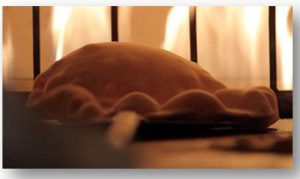 Besides using food to broker appreciation of a culture often misunderstood, Racha and Wassef have actionable portions as well. “When I look at the situation in my homeland, I see its dark, but I also see a light at the end of the tunnel. There is a ray of hope. It is very, very important for us to do things that have direct impact.” So, they sell, for $75, hand blown, exclusive designer candle holders, the ones lined up around the walls (made by Glassybaby, partially owned by Jeff Bezos), $20 of which is donated to the United Nations Syrian Refugee Agency. And they have raised over $2,000 for UNHCR since they started the $5 basket of special breads (Saj bread found across the Levant, Armenian olive bread in honor of Syria’s multicultural traditions, and Khobz be Fleifleh – a unique treat from the northern coastal areas of Syria). Once a month, on a Monday evening, they host a cultural gathering, focusing on one part of the Middle East, and they’ve raised not an insignificant amount from patrons, admirers, activists and friends.
Besides using food to broker appreciation of a culture often misunderstood, Racha and Wassef have actionable portions as well. “When I look at the situation in my homeland, I see its dark, but I also see a light at the end of the tunnel. There is a ray of hope. It is very, very important for us to do things that have direct impact.” So, they sell, for $75, hand blown, exclusive designer candle holders, the ones lined up around the walls (made by Glassybaby, partially owned by Jeff Bezos), $20 of which is donated to the United Nations Syrian Refugee Agency. And they have raised over $2,000 for UNHCR since they started the $5 basket of special breads (Saj bread found across the Levant, Armenian olive bread in honor of Syria’s multicultural traditions, and Khobz be Fleifleh – a unique treat from the northern coastal areas of Syria). Once a month, on a Monday evening, they host a cultural gathering, focusing on one part of the Middle East, and they’ve raised not an insignificant amount from patrons, admirers, activists and friends.
The story, then, is really about Wassef and Racha, and their progressive “experiment” to bypass words and share their motherland culture on a more meaningful, even spiritual level. Mamnoon is, in one sense, an attempt to cut the rope in the tug of war between orient and occident, between respecting heritage and embracing progress, between misinterpretations and reality. It is, they hope, an uncompromising, authentic, and delicious experience that may be a step to changing perceptions, and showcasing a positive side to Syrian, Lebanese, and Iranian life and culture, the way it once was, and, with fortune and good work, will be again.
“Our dream,” concludes Wassef, “is that mamnoon is such a transformative experience that guests spread the word with us.”
After a cardamom-spiked Turkish coffee, I get up to leave and hear the couple in front say “thank you” to Racha and Wassef.
“Shukran,” I say.
Visit: www.mamnoonrestaurant.com
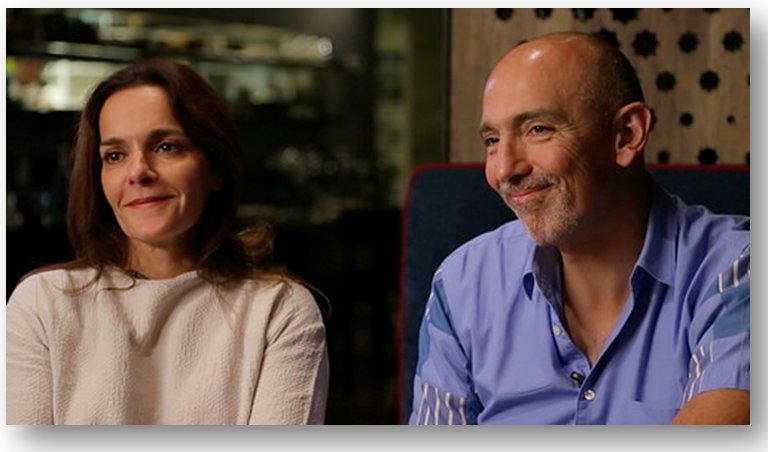

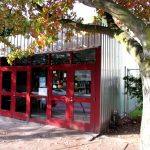
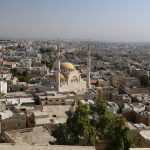



I will definitely be trying this restaurant when I go to Seattle in June. I love Middle Eastern food, and I never made it to Syria…just the border…
Yes, I’ll also have a better shot of getting to Seattle sooner than Syria. I was close during my last trip to the Middle East – someday I would definitely like to visit 🙂